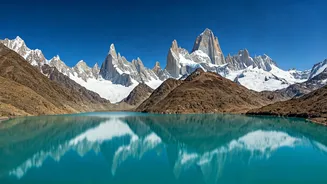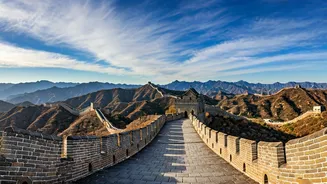Great Wall of China
Stretching thousands of miles across northern China, the Great Wall stands as a testament to the country's ancient engineering prowess. Constructed over
centuries, primarily to protect against invasions, its massive scale and intricate design are astonishing. The wall's winding path weaves through diverse terrains, from deserts to mountains, offering spectacular views. It's more than just a defensive structure; it embodies China's historical narrative and its people's resilience and determination. The different segments built during various dynasties, each with unique architectural features, contribute to the wall's complex and diverse character. Visiting the Great Wall is like walking through the chapters of China's imperial history. It remains a powerful symbol of national unity and a beloved cultural landmark.
Taj Mahal
The Taj Mahal, situated in Agra, India, is a symbol of eternal love. Commissioned by Mughal emperor Shah Jahan for his wife Mumtaz Mahal, this stunning mausoleum showcases exceptional craftsmanship. Built from white marble, the Taj Mahal's design is known for its symmetry, which is beautifully integrated with intricate details. The inlay work with precious stones, the surrounding gardens, and the reflecting pools all contribute to its ethereal beauty. It perfectly blends Persian, Islamic, and Indian architectural styles, representing the harmonious cultural exchange of that period. Every year, millions visit to marvel at its grace and the enduring story it tells of love and loss. It stands as an architectural wonder, a monument to a bond that transcends time.
Pyramids of Giza
The Pyramids of Giza in Egypt are among the oldest and most well-known structures on our planet. These colossal pyramids, built during the Fourth Dynasty, served as tombs for the pharaohs and symbolize the power and wealth of ancient Egypt. The Great Pyramid of Giza, also known as the Pyramid of Khufu, is the largest, constructed with an astounding precision and engineering. They demonstrate the mastery of ancient Egyptians in mathematics, astronomy, and organization. The Sphinx, guarding the pyramids, adds to their mystery and awe. Despite thousands of years passing, the pyramids continue to stand strong, inviting us to contemplate their timelessness and the rich civilization that produced them. These structures are truly a testament to the ancient world's sophisticated society and enduring heritage.
Machu Picchu
High in the Andes Mountains of Peru, Machu Picchu is an ancient Inca citadel, revealing the ingenuity of this civilization. Built in the 15th century, it was hidden from the world for centuries, until its rediscovery in 1911. Its strategic location, intricate stone constructions, and the surrounding natural scenery create a remarkable blend of human artistry and the environment. The precision with which the stones are joined without mortar demonstrates the Incas' sophisticated engineering skills. The purpose of Machu Picchu is still a topic of discussion, with theories pointing to its use as a royal estate, a religious site, or an astronomical observatory. Today, it remains a symbol of the Inca empire's legacy, attracting tourists from across the globe to admire its beauty and mystery. The place represents a historical enigma and a tribute to human adaptability.
Christ the Redeemer
Perched atop Corcovado Mountain in Rio de Janeiro, Brazil, Christ the Redeemer is a striking statue, becoming one of the most recognizable monuments in the world. Completed in 1931, the statue portrays Jesus Christ, with his arms outstretched to offer a welcoming gesture, and symbolizing peace and hope. It is made of reinforced concrete and soapstone and stands at an impressive height, providing vast panoramic views of the city. The Christ the Redeemer statue has turned into a symbol of both Brazil and the Christian faith, drawing millions of visitors each year. It serves as a reminder of faith and a landmark that embraces the city with a sense of security and a spiritual significance. It offers a powerful message of hope and is a testament to the union of art and faith.
Statue of Liberty
The Statue of Liberty, situated in New York City, United States, is a globally recognized emblem of freedom and democracy. A gift from France, it was dedicated in 1886. The statue is made of copper and depicts Libertas, the Roman goddess of freedom. Its iconic image of a woman holding a torch and a tablet inscribed with the date of the American Declaration of Independence is widely known. The Statue of Liberty has become a symbol of welcome for immigrants seeking a new life in America, representing the American ideals of liberty and opportunity. The statue's location on Liberty Island makes it accessible for millions, letting them experience a part of American history and the ideals it embodies. This monument resonates with people worldwide and stands as a beacon of hope.
Sydney Opera House
The Sydney Opera House, located in Sydney, Australia, is a symbol of architectural innovation and artistic expression. Designed by Danish architect Jørn Utzon, its distinctive sail-like shells have become synonymous with the city. Construction on this iconic structure began in 1959 and was completed in 1973. It is a performing arts center, hosting diverse events including opera, ballet, theater, and concerts. The Opera House has multiple venues with striking interiors that complement the exterior design. Set on Bennelong Point, the Sydney Opera House offers stunning views of the harbor, making it one of the most photographed structures in the world. It is a tribute to human creativity and artistic vision, and it welcomes millions of visitors each year, showcasing global talent and celebrating the arts.
Eiffel Tower
Rising above the Parisian skyline, the Eiffel Tower is an enduring symbol of Paris and France. Constructed for the 1889 World's Fair, it was designed by Gustave Eiffel. Initially criticized for its design, the Eiffel Tower rapidly became a symbol of modern engineering. The wrought-iron lattice structure stands tall, offering spectacular city views, and attracting visitors globally. The tower's innovative construction techniques were groundbreaking for the time, marking a significant advancement in architecture. It is lit beautifully at night, adding to its allure and enchanting visitors. The Eiffel Tower remains an iconic destination, representing the city's charm and welcoming millions annually to experience its magic and beauty. It is a historic treasure and an enduring emblem of Parisian sophistication.
Varanasi (and More)
While not a specific landmark in the same way, the inclusion of Varanasi, when juxtaposed with globally recognized landmarks, prompts a wider view of what constitutes a 'wonder.' Varanasi, one of the oldest living cities, in India, offers a unique spiritual experience, characterized by its ghats, temples, and the sacred Ganges River. It's a place where history, culture, and spirituality converge. The inclusion of the query 'Who has more net worth—Priyanka Chopra or Mahesh Babu?' suggests a broader comparison across different fields of interest, linking the cultural impact of celebrities to these incredible landmarks. This kind of comparison suggests the wide range of what the world views as important, from iconic man-made structures to a vibrant spiritual city, and cultural figures. The whole selection of these 'wonders' captures an array of human achievements and global interests.











